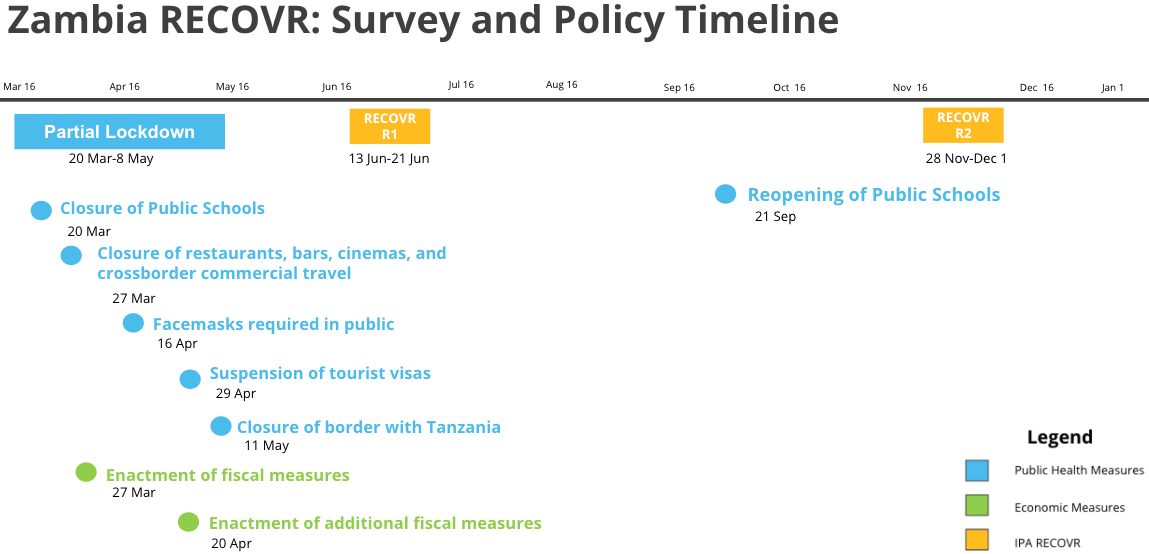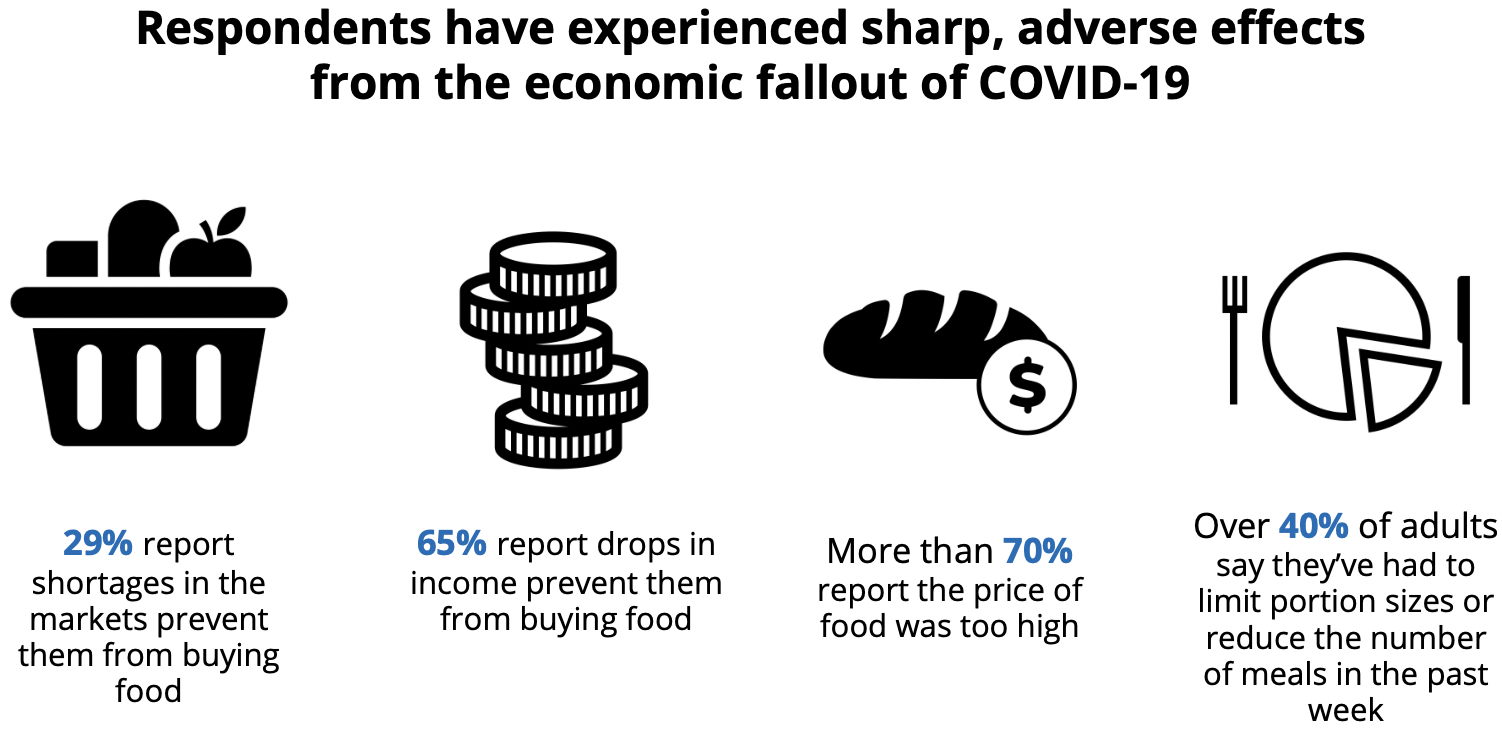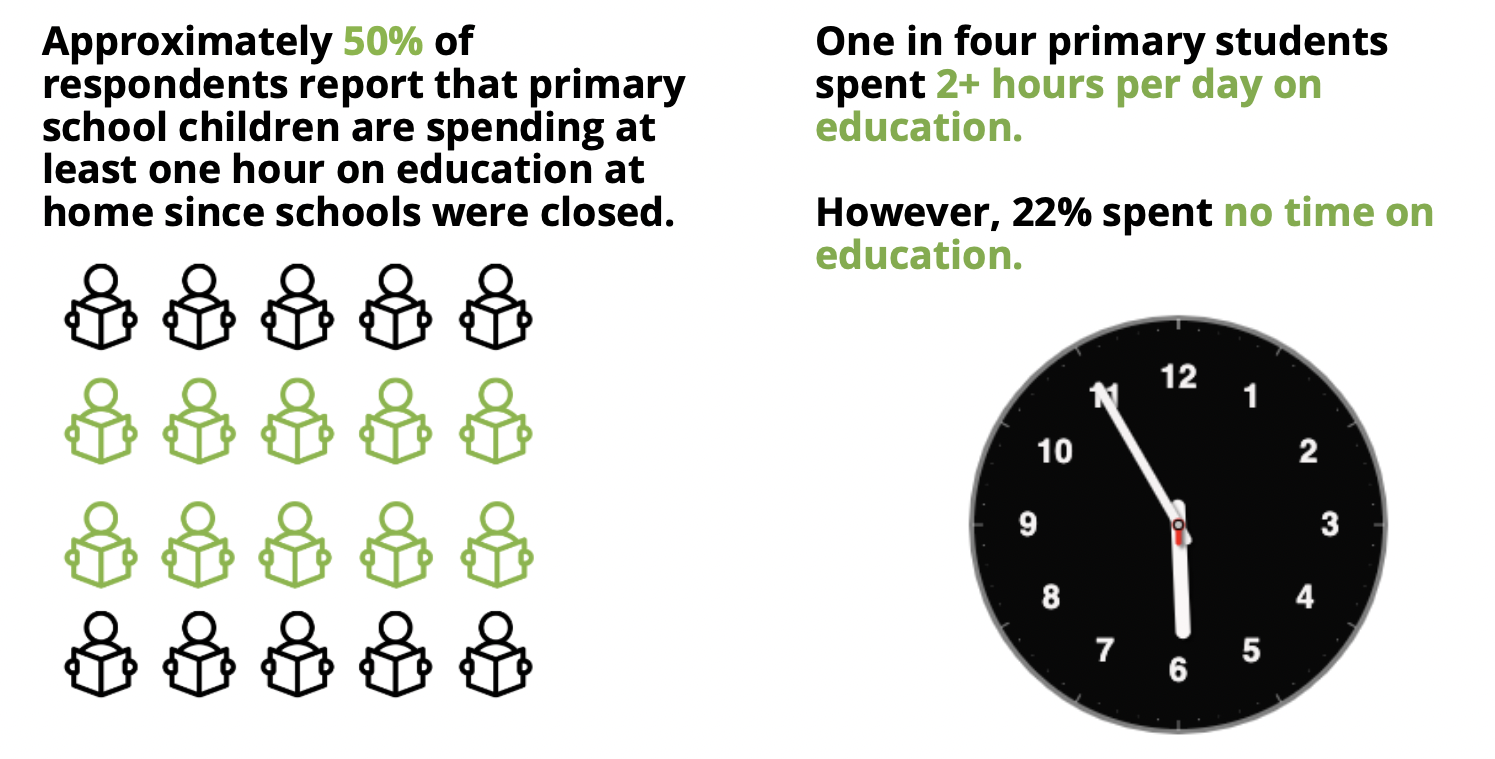Mitigating the Impacts of COVID-19 in Zambia: Insights from RECOVR 2
As part of IPA’s ongoing research around the socioeconomic impacts of COVID-19, we recently held a webinar with the Chronic Poverty Advisory Network highlighting key results of the second round of the RECOVR surveys in Zambia and Rwanda. This blog post summarizes the main findings of the survey in Zambia and policy recommendations. Click here for the blog for Rwanda.
In both countries, there are pockets of progress, including continued adherence to certain virus mitigation measures and promising acceptance rates for vaccinations. Education remains a key concern for parents of learners, with the prospect of potential learning losses. At the same time, as the pandemic continues, challenges remain with respect to food security and the long-term economic damage on livelihoods.
The second round of the Zambia survey was conducted from November 28-December 21, 2020, and ultimately yielded 752 respondents. Of the 1,278 respondents from Round 1, we managed to contact 752 for Round 2. The attrition was balanced across region and demographics, but the results were re-weighted to adjust for any differences across rounds. The second round examined households’ financial situation well after the initial public health and economic responses, and a couple of months after schools reopened (see the timeline below). At the time, Zambia had reported more than 17,500 cumulative cases and just over 350 deaths.

Health and COVID-19 Mitigation
As the pandemic continued, the proportion of respondents who said they felt their household was at risk of contracting COVID-19 increased by 10 percentage points, to 47 percent of respondents. For those who did not feel at risk, the majority (87 percent) of respondents still maintained that it was because they follow preventive measures.
In terms of preventive measures, there were shifts in behaviors regarding face masks. Specifically, the proportion of respondents using homemade facemasks decreased from 80 percent in Round 1 to 64 percent in Round 2, while the proportion using medical face masks increased from 29 percent to 39 percent. We also saw an increase in the proportion of respondents, from 5 percent to 10 percent, indicating that they do not use facemasks. Of this group, more than half consider face masks unnecessary.
Finally, with mass vaccination hopefully on the horizon, we asked respondents how likely it is that they would get vaccinated. At the time of the Round 2 survey, the United States, Canada, the UK, and the European Union were reviewing and issuing emergency authorizations for the Pfizer/BioNTech and Moderna vaccines, and would shortly begin their vaccination campaigns. This question is of key importance to our partners at the Ministry of Health, and inputs from the survey are helping inform the Ministry’s messaging campaigns around vaccinations. Seventy-five percent of respondents said that they would take the vaccine, and 76 percent said they would vaccinate their children. Sixty-nine percent of respondents agree that the vaccine is safe and effective, which while comparable to other countries, suggests that there is still a need for clear and accessible information about the vaccines to help to address remaining skepticism. Sixty-five percent of respondents trusted doctors and other healthcare professionals for vaccine information, which also suggests that healthcare professionals have a critical role to play in vaccine acceptance.
During the webinar, we were joined by Dr. Godfrey Biemba, Director and Chief Executive Officer of the National Health Research Authority (NHRA), who provided further policy insights from the survey’s findings on health trends. He noted that respondents’ reported intention to vaccinate, is a very promising foundation around which Zambia can build its vaccination campaign, but he was especially concerned about the remaining 25 percent of respondents that indicated hesitancy around immunization. Given Zambia’s policy of voluntary vaccination, Dr. Biemba noted that the NHRA needs to work with the Ministry of Health to develop clear, evidence-based messages to inform Zambians about the benefits of the vaccines, while also appealing to motivating factors (e.g. self-protection, protecting one’s family, etc.)
Dr. Biemba also highlighted the apparent paradox in respondents’ increased risk perceptions of COVID-19 and stated a decrease in the usage of facemasks. He noted that this disconnect between respondents’ high level of risk perception and lower adherence to preventive measures, such as masks, is influenced by many factors and not limited to risk perception. Nevertheless, he explained, that this discrepancy underscores the need to utilize behavior change strategies, such as the COM-B framework. Under this model, behavior change is encouraged via an individual’s capability, opportunity, and motivation, all of which are in turn influenced by the surrounding environment and established social norms. Dr. Biemba encouraged Zambia’s health institutions to apply such evidence-based models for behavior change to their messaging and to continue to identify and test “what works” for promoting preventive measures and to consider testing other interventions, such as conditional cash transfers for adherence to preventive measures, as the pandemic continues.
Food Security and Financial Resilience
In our prior post, we highlighted the deep effects that the pandemic had already wrought on Zambian households. Unfortunately, those trends continued, with more respondents reporting they’d sold assets (35 percent), skipped required loan payments (23 percent), and bought fewer inputs for their farms/businesses (39 percent) to cover basic household expenses. Food insecurity also persists.

In terms of financial security, one in five respondents indicated that they had no source of income for raising emergency funds of K800 within 30 days. More than half (53 percent) of respondents indicated they had depleted their savings to cover basic household expenses like food or healthcare.
Education
In Zambia, schools closed on March 20, 2020, and reopened on September 21, 2020. Our policy partners at the Ministry of General Education are interested in understanding the long-term effects on learning and educational experiences, as teachers, parents, and students alike continue to navigate education during the pandemic. When we first asked parents whether they were concerned about their children’s education in Round 1 in June, only two percent responded that they were concerned, but by the end of November in Round 2, it had risen to14 percent. For those who are concerned, the majority (68 percent) are concerned about children falling behind in their education.
We asked parents how children were spending their time and answers suggest that there are quite varied experiences. For example, while twenty-five percent of primary students reported spending 2+ hours per day on education, there was also 22 percent that spent no time on education. These results need to be interpreted with some caution, however, given that part of the second round of the survey coincided with school holidays and this timing could have affected parents’ recall and the answers they gave.

We also asked about barriers keeping children from spending time on education, and the main reasons cited were access to television, a lack of motivation, and competing priorities (such as assisting with household work). The varying amounts of time devoted to education in each household suggest that it will be important for educators to assess literacy and numeracy skills upon resuming full-time learning.
Economic Activity and Employment
Finally, we also note trends across the two rounds that can help to inform the government’s strategy for economic recovery. While respondents largely indicated maintaining their employment levels, a majority experienced decreased earnings across both rounds (53 percent and 59 percent respectively). This held true over time, across rural and urban regions, and for those living below the poverty line.
We found that urban heads of households were more likely to report they’d worked more hours in the last week than a typical week in February 2020, compared to their rural counterparts (51 percent vs. 33 percent). In addition, compared to a typical week in February 2020, women were 19 percentage points more likely than men to indicate “no earnings.” Such differential experiences can inform targeted policy responses to stimulate employment and provide income-generating opportunities to groups that are harder hit by the economic shock of the pandemic.

Policy Implications and Recommendations
The results from RECOVR Round 2 paint a picture of the ongoing impact of the pandemic, which necessitates evidence-based policy responses for immediate relief and long-term recovery. Across the social protection and health sectors, policymakers can consider the following recommendations:
Social Protection
Expansion of social protection programs is a critical aspect of countries’ pandemic responses, and more than 200 countries or territories have implemented or announced plans composed of more than 1,400 social measures. Policymakers can consider key dimensions of expanding social assistance outlined in IPA’s policy brief Key Decisions for COVID-19 Social Protection in Low- and Middle-Income Countries.
Specifically, policymakers should consider: which individuals will be offered new or expanded social protection benefits; how such individuals can be identified, verified, and enrolled in a social protection program; whether benefits should be provided as cash transfers or in-kind transfers (e.g. food); and, if cash transfers are selected, whether they should be provided through digital or physical channels. The brief discusses further guiding questions and considerations for structuring social assistance programs, such as whether new programs can be integrated with existing social protection schemes, and whether there is sufficient existing mobile money digital infrastructure for rolling out digital payments.
Health
Encouragingly, respondents in both Rwanda and Zambia indicate high vaccine acceptance rates (85 percent and 75 percent, respectively), and this level of intent can be used to inform messaging and registration campaigns. It will be especially important to convert the intent to vaccinate to follow through with vaccination (especially with a two-dose regimen). Behaviorally-informed nudges, commitment devices, and messaging campaigns around social norms and acceptance are being tested and utilized around the world, and insights from immunization efforts in other contexts, such as social signaling, can be considered for COVID-19 campaigns.
Apart from individually-targeted campaigns, as the WHO notes, it is also critical to create an enabling environment for immunization. For example, location and accessibility of vaccination sites, reducing any non-monetary costs involved (e.g. traveling to a site, time, missing work, etc.), transparent and accessible information, and the quality of the experience of being vaccinated, can all play a part in the follow-through of actually getting the vaccine.











